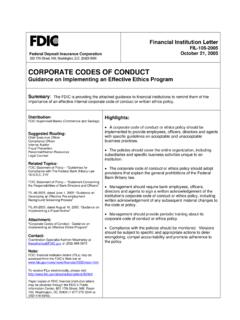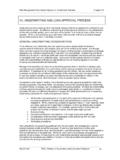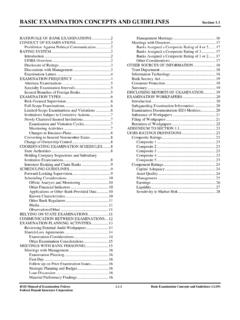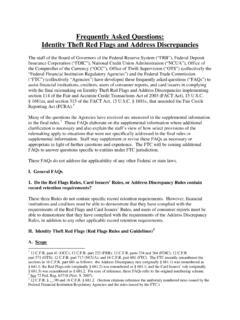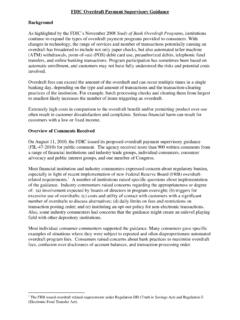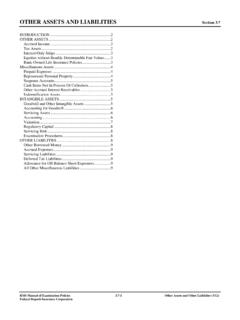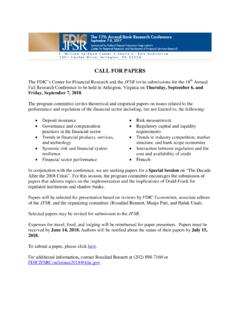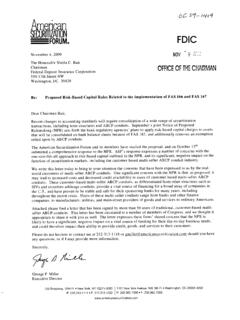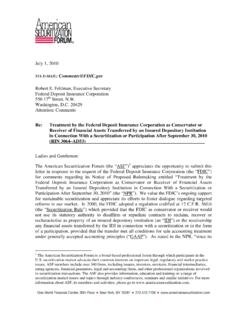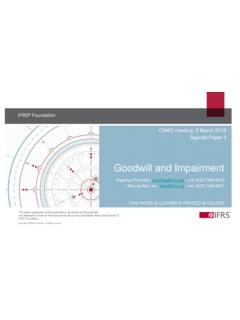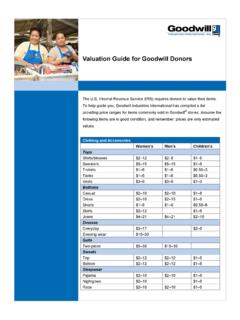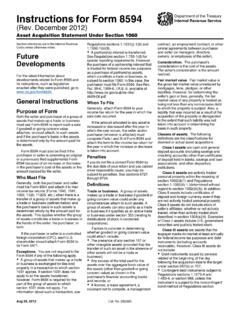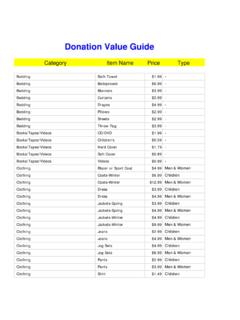Transcription of The New Basel III Definition of Capital: Understanding the ...
1 27 Supervisory Insights Winter 2013 The New Basel III Definition of Capital: Understanding the Deductions for Investments in Unconsolidated Financial InstitutionsOn July 9, 2013, the FDIC Board of Directors approved the Basel III interim final rule (new capital rule or rule). The new capital rule, which takes effect for community banks in January 2015, is intended to strengthen the quality and increase the required level of regulatory capital in order to promote a more stable and resilient banking This article is part of the FDIC s effort to provide techni-cal assistance to community banks on the new capital rule. It focuses on a specific aspect of the rule that changes the treatment for certain capital investments that community banks may hold: the deductions from regulatory capital for investments in the capital instruments of unconsoli-dated financial on Basel IIIAn important goal of the new capital rule is to strengthen the Definition of regulatory capital to ensure it consists of elements that can absorb loss.
2 Begin-ning with the Call Report dated March 31, 2015, community banks will report a new regulatory capital measure, common equity tier 1 (CET1), which is limited to capital elements of the highest quality. Some banks may have other capital elements such as noncu-mulative perpetual preferred stock; these, if any, may be recognized as additional tier 1 capital, which when added to CET1 equals tier 1 capital. Finally, a bank s total regulatory capi-tal may also include certain tier 2 elements (see Table 1).Table 1 Components of Regulatory CapitalTotal capitalTier 1 capitalCommon Equity tier 1 capital (CET1)Composed of common stock and surplus, retained earnings, accu-mulated other comprehensive income (unless an opt-out is chosen*)
3 And qualifying minority interestAdditional tier 1 capitalNoncumulative perpetual preferred stock and related surplus, and qualifying minority interestTier 2 capitalSubordinated debt, qualifying minority interest, limited amounts of gains on available-for-sale equity securities, and the allowable portion of the allowance for loan and lease losses*All banks, other than advanced approaches banks, are given a one-time irrevocable option to continue to treat certain accumulated other comprehensive income (AOCI) components as they are treated under the current general risk-based capital rules. The AOCI opt-out election must be made on the Call Report filed as of March 31, The rule, which is substantively identical to the rule issued by the Federal Reserve and the Office of the Comp-troller of the Currency, is described in FIL-31-2013.
4 Additional resources are available at Insights Winter 2013 The new rule includes a series of adjustments and deductions to arrive at the final value of reported CET1 used to meet the regulatory capital requirements (see Table 2). Some adjustments and deductions are straightforward and longstanding, such as the deduction of goodwill . Others are conceptually straightforward but new. For example, certain types of deferred tax assets are automatically deducted, and all intangible assets are deducted except a limited amount of mortgage servicing assets. In addition, there are threshold deductions, which are new and not quite as straightfor-ward.
5 The remainder of this article will describe the threshold deduc-tions and work through an extended example to demonstrate the deduction Call Report instructions will also be available to walk banks step by step through these calculations. It is expected that the once a bank has identified its investments that are subject to the threshold deductions (if any), the calculation of those deduc-tions and applicable transitions will be performed within Call Report software. It should also be noted that the exam-ples in this article involve relatively large capital deductions and a rela-tively large proportion of additional tier 1 capital within the example bank s tier 1 capital.
6 The amounts in the examples are to help explain the calculations and are not viewed as representative of typical banks. Table 2 Regulatory Capital Deductions and AdjustmentsDeduction or AdjustmentCommon Items for Community Banks*Regulatory Capital Deductions from CET1 capitalGoodwillIntangible assets (other than mortgage servicing assets (MSAs))Deferred Tax Assets (DTAs) that arise from Net Operating Losses and tax credit carryforwardsRegulatory Adjust-ments to CET1 capital Unrealized Gains and Losses included in Accumulated Other Comprehen-sive Income (if the opt-out election is not chosen)Threshold Deduc-tions to CET1 capital Non-significant investments in the capital of unconsolidated financial insti-tutions exceeding 10% of the bank s CET1, after regulatory capital deduc-tions and adjustmentsItems subject to the 10% and 15% CET1 capital deduction thresholds.
7 DTAs arising from temporary differences that could not be realized through net operating loss carrybacksMSAsSignificant investments in the capital of unconsolidated financial institu-tions in the form of common stock* This chart does not include all the deductions or adjustments a community bank may be required to make and only includes a few of the more common deductions or adjustments for illustrative purposes. See 12 CFR (a)-(d) for a complete list of items subject to deduction or adjustment. New Basel III Definition of Capitalcontinued from pg. 2729 Supervisory Insights Winter 2013 Reasons for these threshold deductions First and foremost, the purpose of the threshold deductions for invest-ments in financial institutions is to limit the double counting of capital in the financial system.
8 When banks invest in capital instruments of other financial institutions, problems at one institution can directly affect the financial health of other banks invest-ing in its capital instruments. A good example is the losses some banks experienced on their investments in collateralized debt obligations (CDOs) of trust preferred securities of other banking organizations. This type of interdependence among banks can exacerbate a financial crisis. A. What is the starting point for the threshold deductions?If a bank has investments in the capi-tal instruments of a financial institu-tion, then these investments may be subject to the threshold deductions.
9 The threshold deductions are made to CET1 after regulatory capital deduc-tions and regulatory adjustments (see the first two panels of Table 2). B. What is the Definition of a financial institution?If certain investments in financial institutions are to be deducted, the first question must be, for what types of financial institutions? The answer is in the Definition of financial institu-tion in the Basel III regulation, which determines whether any of a bank s capital investments may be subject to the threshold deductions. In brief, financial institutions include banks (including bankers banks), bank holding companies, savings and loan holding companies, and other insti-tutions cited in the Definition .
10 For purposes of the threshold deductions, financial institutions do not include government-sponsored enterprises (for example, Federal Home Loan Banks), small business investment compa-nies, community development finan-cial institutions, mutual funds, and employee benefit plans. The Definition also includes a predominantly engaged test as a catch-all for types of financial institu-tions not expressly listed. Investments in the capital instruments of such companies would also be subject to the threshold deduction. If a community bank owns more than 10 percent of a potential unconsolidated financial institution s common stock, the bank would have to apply this test.
